
Scorpions are predatory arachnids of the order Scorpiones. They have eight legs and are easily recognized by a pair of grasping pincers and a narrow, segmented tail, often carried in a characteristic forward curve over the back and always ending with a stinger. The evolutionary history of scorpions goes back 435 million years. They mainly live in deserts but have adapted to a wide range of environmental conditions, and can be found on all continents except Antarctica. There are over 2,500 described species, with 22 extant (living) families recognized to date. Their taxonomy is being revised to account for 21st-century genomic studies.

Uropygi is an arachnid order comprising invertebrates commonly known as whip scorpions or vinegaroons. They are often called uropygids. The name "whip scorpion" refers to their resemblance to true scorpions and possession of a whiplike tail, and "vinegaroon" refers to their ability when attacked to discharge an offensive, vinegar-smelling liquid, which contains acetic acid. The order may also be called Thelyphonida. Both names, Uropygi and Thelyphonida, may be used either in a narrow sense for the order of whip scorpions, or in a broad sense which includes the order Schizomida.

Reginald Innes Pocock F.R.S. was a British zoologist.
The taxonomy of scorpions deals with the classification of this predatory arthropod into 13 extant families and about 1,400 described species and subspecies. In addition, 111 described taxa of extinct scorpions are known.
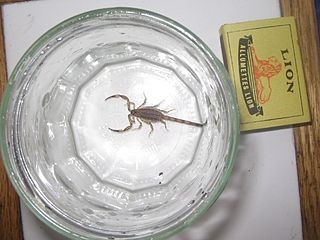
Isometrus is a genus of scorpion belonging and being eponymous to the family Buthidae. Some species are currently assigned to the genus Reddyanus.

Scorpionidae is a family of burrowing scorpions or pale-legged scorpions in the superfamily Scorpionoidea. The family was established by Pierre André Latreille, 1802.
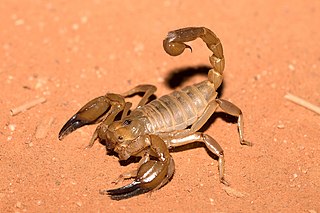
Urodacus is a genus of scorpion belonging to the family Urodacidae. It was described by German naturalist Wilhelm Peters in 1861. The type species is U. novaehollandiae. Its species are native to Australia, and dig burrows. The genus was placed in its own family in 2000. Before this, the group had been a subfamily Urodacinae within the family Scorpionidae.
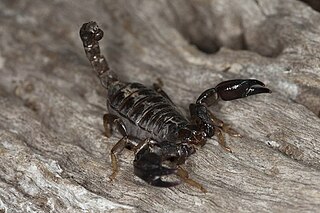
Urodacus manicatus, commonly known as the black rock scorpion, is a species of scorpion belonging to the family Urodacidae. It is native to eastern Australia.

Cheloctonus jonesii is a species of scorpion in the family Hormuridae native to southern Africa.
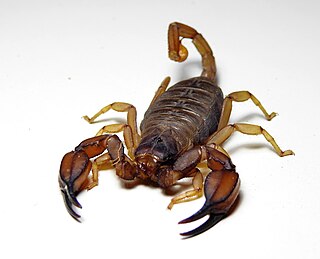
Urodacidae is a family containing two genera of scorpions, both of which are endemic to Australia. It was first described by British zoologist Reginald Innes Pocock in 1893. Formerly a subfamily (Urodacinae) of the Scorpionidae, it was later raised to family rank. Its sister taxon is the monotypic family Heteroscorpionidae, the species of which are confined to Madagascar.
Urodacus carinatus is a species of scorpion in the Urodacidae family. It is native to central Australia, and was first described in 1911 by British arachnologist Arthur Stanley Hirst.
Urodacus centralis is a species of scorpion in the Urodacidae family. It has a limited range in central Australia, and was first described in 1977.
Urodacus butleri is a species of scorpion in the Urodacidae family. It is endemic to Australia, and was first described in 2012.
Urodacus excellens is a species of scorpion in the Urodacidae family. It is endemic to Australia, and was first described in 1888 by British zoologist Reginald Innes Pocock.
Urodacus hoplurus is a species of scorpion in the Urodacidae family. It is endemic to Australia, and was first described in 1898 by British zoologist Reginald Innes Pocock.
Urodacus macrurus is a species of scorpion in the Urodacidae family. It is endemic to Australia, and was first described in 1899 by British zoologist Reginald Innes Pocock.
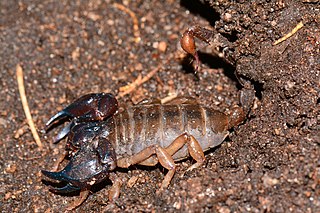
Urodacus planimanus is a species of scorpion in the Urodacidae family. It is endemic to Australia, and was first described in 1893 by British zoologist Reginald Innes Pocock.
Urodacus spinatus is a species of scorpion in the Urodacidae family. It is endemic to Australia, and was first described in 1902 by British zoologist Reginald Innes Pocock.
Urodacus giulianii is a species of scorpion in the Urodacidae family. It is endemic to Australia, and was first described in 1977 by L. E. Koch.

Urodacus novaehollandiae, also known as the coastal burrowing scorpion or black sand scorpion, is a species of scorpion in the Urodacidae family. It is endemic to Australia, and was first described in 1861 by German naturaliat Wilhelm Peters.










